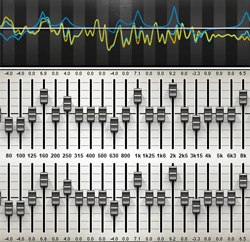
Boxy – 400 Hz is the fundamental tone of most male and some female voices. Too much of it can trap the energy into a localized source without any ‘air” or ‘breadth.”
Honky – 800 Hz is the leading culprit behind exquisite grand pianos that sound like a cheap honky-tonk upright through the PA. The pianist will thank you for removing 4-6 dB in this region.
Nasal – 1000 Hz (1 kHz) is the nasty tone in some reproduced lyrical vocals as well as the tone that gives away a digital piano as an unreal instrument. Take out 3 dB and watch the reaction.
Vox Box – 2 kHz is the chosen pre-emphasized frequency for many stage grade vocal mics. While it allows the vocal to “cut through” the mix, too much of it can spoil a good thing. It’s already boosted in the mic; don’t add to it.
Fatigue – 3.5 kHz is the most sensitive region of the human hearing system. Unfortunately, many audio engineers have significant hearing loss around this zone, so they compensate with too much of too much. If your ears tire of the mix after 30 minutes, it’s time to pull back 4 dB here.
Sizzling – 5 kHz is a wonderfully definitive region, but too much on hi-hat and snare can reduce the audience to mush. Super cardioid condenser mics tend to emphasize 5 kHz and produce a “harsh” tonality. However, much more than a 3 dB cut risks losing the vocal articulation.
Zingers – 8 lHz is a necessary part of music, but it removes heads when it oscillates into feedback, so never add it, just subtract its decade differential at 800 Hz.
In fact, any needed boost can usually be found by reducing the frequency ten times less or more than its value. To increase clarity at 4 kHz, reduce 400 Hz by 4 dB. To get the vocals to cut through at 2 kHz, remove energy at 200 Hz. For pounding kick drum at 60 Hz, reduce 600 Hz.
As with everything in audio, these tips are just a guideline. However, they have proven effective in hundreds of live concerts and thousands of worship services, so feel free to start turning, as long as it’s to the left.
Kent Morris is noted for his church sound training abilities. He has more than 30 years of experience with A/V, has served as a front of house engineer for several noted performers and is a product development consultant for several leading audio manufacturers.
